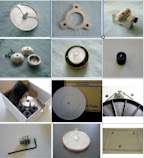Monday January 23, 2012
Mike’s mechanics
By LIM JUAN
A fancy lot of bits and bobs for those who can’t leave their Rega turntables alone.
I TESTED a locally-made replacement acrylic platter for Rega turntables some years back for AudioFile, and came away impressed. The protagonist behind that item has been busy and since then, produced, among other replacement/upgrade parts, an aluminium sub-platter, silicon rubber belts, a stainless steel pulley which will allow two belts to be fitted, and a thrust bearing to be glued to the bottom of Rega’s motor.
These have come to be known as the “Michael Lim upgrade parts”. Lim (no relation to moi) seems disinclined to coin an official brand name for his items, preferring to be a hobbyist who is willing to sell stuff he’s made to others.

Charge that Rega! These are among the numerous aftermarket parts available for Rega turntables (above and below).
“I need something fun to do in my retirement,” says he.
It was an opportune time to test some of these items as I recently acquired a mint used Rega P1. The test procedure was not ideal as Lim supplied a separate P1 turntable already fitted with the replacement parts, but I was able to substitute some of them back and forth to the point I felt confident with my observations to report them.
Rotating parts
My first observation is that unless one replaces the bog standard MDF platter on the stock P1 with something better, these tweaks won’t give optimum returns for the money. Improving the platter made the most noticeable difference, and also allowed the other replacement parts’ perceived differences to come forth.
Naturally, I used Lim’s acrylic platter, but he opines that one would get good mileage from Rega’s own glass platters.

The combined effect of these bits brought a better sense of drive and resolution of detail, the last no doubt the result of a lowered noise floor. The basic P1 rhythmic throb and sense of propulsion in the music is not diminished, but sonic images now come across as more solid and present, with sharper outlines and better scale and dimension. I perceived a cleaner sounding treble also.
Listening to the aluminium sub-platter in isolation in the stock P1, one senses a slightly quieter background and more stable images – noticeable, but hardly earth shattering, for the money. As the single most expensive of Michael’s replacement parts, targeting the sub-platter as first change may not be the most sensible, at least when upgrading a stock P1.
Cumulatively, the modded P1 (with acrylic platter) certainly sounded like a superior turntable to the P1 (also when with acrylic platter). Somewhat surprisingly, I now thought the stock version to be somehow more listenable on certain material in spite of its sonic inferiority.
With the better ambience and clearer detail retrieval, one notices all the more the “leftover” weaknesses from the stock P1, that of pitch instability, painfully highlighted by spinning Beethoven’s Piano Sonatas. On one passage from Appasionata, the modded P1 conveyed the impression the pianist might have been mildly sea sick. You’ll find yourself considering the Rega (official) motor upgrade in no time!
The circle game
These upgrade parts would perhaps be more effective when one is contemplating modding a higher Rega model (especially an older sample thereof) and not so much for improving a “starter” P1. Note that use of the dual pulley means one loses the 45rpm function if one does not have electronic speed selection.
These bits (save for the acrylic platter and silicon belt) don’t depart from the engineering choices Rega itself implements in its superior models. Rega, however, does not sell such parts individually to allow lower model owners to upgrade them.
Lim’s prices are attractive and the results are good, so they warrant being checked out if you are wondering how to get better sound from your LPs on a Rega table without having to spend large sums.




























